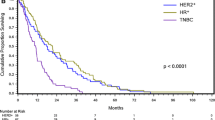Abstract
The incidence of leptomeningeal metastases (LM) in patients with breast cancer (BC) is increasing as a result of increased screening and improved patient survival. However, the median survival time after diagnosis of LM is between 5 weeks (without any treatment) and 5 months (for aggressively treated patients). In an attempt to identify clinicopathological risk factors for LM, we carried out a case-control study of 100 women with BC. Fifty patients with BC and LM were enrolled and an additional 50 patients with BC and no CNS metastases including leptomeningeal spread were selected as controls. Patients who had developed LM were selected between December 2006 and August 2008. The control group was matched for: age at diagnosis, year of diagnosis, and initiation of chemotherapy at BC diagnosis. The ILC type (P = 0.03), ER-negative (P = 0.01) and PR-negative status (P = 0.03), and initial M+ status at BC diagnosis (P = 0.008) tended to be more frequent in LM patients. These characteristics should lead to early appropriate assessments being performed in this targeted population when a neurological complaint appears, in order to detect LM as soon as possible.


Similar content being viewed by others
References
Boogerd W (1996) Central nervous system metastasis in breast cancer. Radiother Oncol 40:5–22
Tosoni A, Franceschi E, Brandes AA (2008) Chemotherapy in breast cancer patients with brain metastases: Have new chemotherapic agents changed the clinical outcome? Crit Rev Oncol Hematol 68(3):212–221
Groves MD (2010) New strategies in the management of leptomeningeal metastases. Arch Neurol 67(3):305–312
Chamberlain MC (2009) Leptomeningeal metastasis. Curr Opin Neurol 22(6):665–674
Lin NU, Bello JR, Winer EP (2004) CNS metastases in breast cancer. J Clin Oncol 22:3608–3617
Elston CW, Elis IO (1991) Pathological prognostic factors in breast cancer. I. The value of histological grade in breast cancer: experience from a large study with long-term follow-up. Histopathology 19(5):403–410
Wolff AC, Hammond ME, Schwartz JN, American Society of Clinical Oncology/College of American Pathologists et al (2007) American Society of Clinical Oncology/College of American Pathologists guideline recommendations for human epidermal growth factor receptor 2 testing in breast cancer. J Clin Oncol 25(1):118–145
Krauseneck P (1998) Clinical relevance and current problems of neoplastic meningosis. J Neurooncol 38:93–95
Gonzales-Angulo AM, Cristofanilli M, Strom EA et al (2004) Central nervous system metastases in patients with high-risk breast carcinoma after multimodality treatment. Cancer 101:1760–1766
Altundag K, Bondy ML, Mirza ND et al (2007) Clinicopathologic characteristics and prognostic factors in 420 metastatic breast cancer patients with central nervous system metastasis. Cancer 110:2640–2647
Chamberlain MC (1998) Leptomeningeal metastases: a review of evaluation and treatment. J Neurooncol 37:271–284
Chang EL, Maor MH (2003) Standard and novel radiotherapeutic approaches to neoplastic meningitis. Curr Oncol Rep 5(1):24–28 (review)
Li CI, Daling JR, Malone KE (2003) Incidence of invasive breast cancer by hormone receptor status from 1992 to 1998. J Clin Oncol 21(1):28–34
Evans AJ, James JJ, Cornford EJ et al (2004) Brain metastases from breast cancer: identification of a high-risk group. Clin Oncol 16(5):345–349
Ryberg M, Nielsen D, Osterlind K et al (2005) Predictors of central nervous system metastasis in patients with metastatic breast cancer: a competing risk analysis of 579 patients treated with epirubicin-based chemotherapy. Breast Cancer Res Treat 91(3):217–225
Tham YL, Sexton K, Kramer R, Hilsenbeck S, Elledge R (2006) Primary breast cancer phenotypes associated with propensity for central nervous system metastases. Cancer 107:696–704
Slimane K, Andre F, Delaloge S et al (2004) Risks factors for brain relapse in patients with metastatic breast cancer. Ann Oncol 15(11):1640–1644
Wolstenholme V, Hawkins M, Ashley S, Tait D, Ross G (2008) HER2 significance and treatment outcomes after radiotherapy for brain metastases in breast cancer patients. Breast 17(6):661–665
Davoli A, Hocevar BA, Brown TL (2010) Progression and treatment of HER2-positive breast cancer. Cancer Chemother Pharmacol 65(4):611–623
Lai R, Dang C, Malkin M, Abrey L (2004) The risk of central nervous system metastases after trastuzumab therapy in patients with breast carcinoma. Cancer 101:810–816
Orvieto E, Maiorano E, Bottiglieri L et al (2008) Clinicopathologic characteristics of invasive lobular carcinoma of the breast: results of an analysis of 530 cases from a single institution. Cancer 113(7):1511–1520
Rakha EA, El-Sayed ME, Green AR, Lee AH, Robertson JF, Ellis IO (2007) Prognostic markers in triple negative breast cancer. Cancer 109(1):25–32
Basu S, Chen W, Tchou J et al (2008) Comparison of triple-negative and estrogen receptor-positive/progesterone receptor-positive/HER2-negative breast carcinoma using quantitative fluorine-18 fluorodeoxyglucose/positron emission tomography imaging parameters: a potentially useful method for disease characterization. Cancer 112(5):995–1000
Schnitt SJ, Guidi AJ (2004) Pathology of invasive breast cancer. In: Harris JR, Lippman ME, Morrow M, Osborne CK (eds) Disease of the breast cancer, vol 34, 3rd edn. Lippincott, Williams and Wilkins, Philadelphia, pp 541–584
Clarke JL, Perez HR, Jacks LM, Panageas KS, DeAngelis LM (2010) Leptomeningeal metastases in the MRI era. Neurology 74:1449–1454
Conflict of interest
No conflict of interest to declare for any author.
Author information
Authors and Affiliations
Corresponding author
Rights and permissions
About this article
Cite this article
Le Rhun, E., Taillibert, S., Zairi, F. et al. Clinicopathological features of breast cancers predict the development of leptomeningeal metastases: a case-control study. J Neurooncol 105, 309–315 (2011). https://doi.org/10.1007/s11060-011-0592-7
Received:
Accepted:
Published:
Issue Date:
DOI: https://doi.org/10.1007/s11060-011-0592-7




